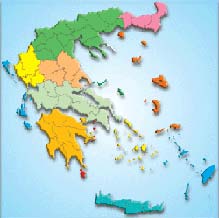
Please click on the map,
the region you want to visit |
|
|
|
|
| |
|
 |
Tourist guide of Paros |
|
PAROS
With its golden sandy beaches, green fertile valleys
full of olive trees and grapevines, bougainvillea,
roses and geranium in bloom - Paros is experiencing
an ever-growing increase in tourism. The narrow
lanes of Parikia and Naousa will entice you to
wander for hours. Petaloudes, Lefkes, Marpissa,
Asklipio and Dilio are all areas that you mustn't
miss.
Paroikia, the capital and port of the island,
is full of neoclassical mansions and quaint narrow
streets topped with archways. The Ekatontapyliani
(Church of a Hundred Doors) the Moni Longovardas
and the Moni Christou tou Dasous are all worth a
visit.
Alyki is a seaside village with clean calm
waters. Just before Alyki you can see the remains
of an ancient city below the sea's surface.
Dryos has many small bays with golden sand,
the largest of which is Chrysi Akti. On the beach
are sections of Ancient Neosoikon.
The village of Lefkes is one of the most
beautiful on Paros. It's verdant with pine, eucalyptus,
olive and almond trees. You can purchase finely-made
woven goods and ceramics there.
Marpissa is bright with white island houses
and many significant churches. Just under the village
is the sandy beach Molos and Kalogeros Cove with
its crystal clear waters.
The remains of a castle are evident to the east
of the village on Kefalos hill.
The villages of Marmara and Gravoulas are also quite
beautiful.
Piso Livadi and Logaras are tourist
resorts. The Moni AgParos AntonParos is built above
them with an impressive view.
The closest crossing for Antiparos is at Pounta.
Don't forget to try Paros' wine and vinegar, to
eat 'Revithia sto Fourno'(baked chickpeas), 'Revithokeftedes'
(chickpea patties), 'Kakavia' (freshly-caught fish
soup), 'Raviolia' and to buy ceramics, leather goods
and jewellery. Paros is reknowned for its fine crafts. |
|
|